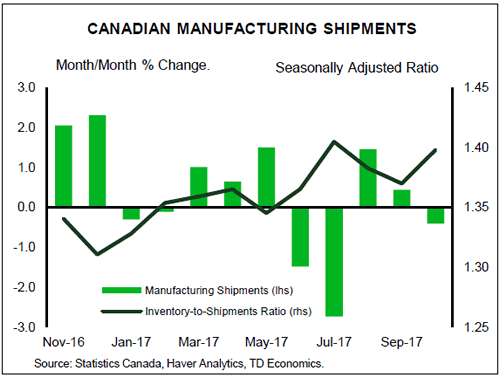U.S. Highlights
- The second week of 2018 marked another strong performance in equity markets. While the advance did take a breather midweek, the main American stock indices resumed their upward trajectory, rising to new highs. The rally received an added fillip from oil prices, which gained additional ground, thanks in part to a bullish inventory report.
- Economic reports drove in the point that the U.S. economy ended the year on solid footing. Retail sales rose 0.4% m/m in December, while November sales received a healthy upward revision. Fourth quarter consumption growth is now expected to come in at around 3.3% (ann.), which should help propel growth forward by a robust 2.6% at year-end.
- On the inflation front, data out this morning suggests that price pressures appear to be building. Core CPI saw a stronger-than-expected 0.3% m/m increase, which lifted the y/y pace to 1.8%. Altogether, this week’s data helps bolster support for a March rate hike, with two more expected later this year.
Canadian Highlights
- The West Texas Intermediate oil price hit a 3-year high of US$64 per barrel this week, as the market focused on falling U.S. inventories and tensions in Iran.
- Housing starts totaled a healthy 217k units in December, bringing the trend rate to a solid 227k units.
- The Bank of Canada’s Business Outlook Survey revealed that sentiment among firms remained positive in the final quarter of 2017, with healthy hiring and investment intentions pointing to economic strength.
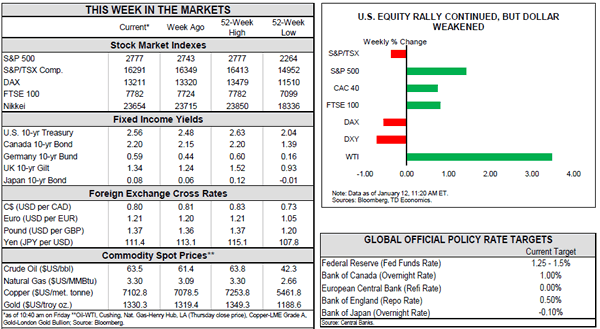
U.S. – Upbeat Data Bolster Case For March Hike
The second week of 2018 marked another strong performance in equity markets. Tax reform and upbeat economic data helped support investor sentiment. Markets hiccupped temporarily mid-week on renewed concerns about NAFTA, and an unsubstantiated report that senior Chinese officials have recommended slowing or halting the purchase of U.S. Treasuries. The main American stock indices shrugged off these concerns, and resumed their upward trajectory to new highs. The rally received an added fillip from higher oil prices, thanks in part to a bullish inventory report.
Economic reports reinforced the view that the U.S. economy ended the year on solid footing, setting the stage for robust momentum heading into 2018. Retail sales rose 0.4% m/m in December, while November received a healthy upward revision to 0.9% from 0.8% previously. Gains were broad based, with strength seen in categories such as building material, food & beverage, and non-store retailers. Considering these data, fourth quarter consumption growth is expected to come in at around 3.3% (annualized), which should help real GDP growth advance by a solid 2.6% at year-end.
Complementing strong consumer spending, small business owners remained upbeat. Although confidence pulled back slightly in December, the reading remained at historically high levels. Moreover, the recent upbeat trend in optimism has been accompanied by the increased difficulty in finding qualified workers (Chart 1). Given the tightness in the labor market, businesses will need to boost worker compensation in order to attract and retain talent. They will have an improved ability to do so thanks to tax reform which will lower some of the tax burden. This narrative, corroborated by an upward trend in the share of small businesses planning to raise compensation, provides additional comfort with regards to our inflation outlook.
On that note, inflation data out this morning suggests that price pressures appear to be falling into place. While headline inflation was held back by declining energy prices, recording only a modest uptick, the more important aspect of the report was that core CPI saw a stronger-than-expected 0.3% m/m increase, buoyed by gains in shelter costs, healthcare-related costs and vehicle prices. This nudged up the y/y pace of core inflation to 1.8% in December (Chart 2). The lack of price pressures has long puzzled the Fed, holding back the pace of interest rate normalization. But, this week’s data is consistent with a Fed that is likely to hike this March and twice more in 2018.
The potential for overheating, given the combined impact of fiscal stimulus and a tight labor market, may necessitate a slightly faster pace of hikes. But for now, we views risks for three hikes in 2018 as roughly balanced. For instance, the fact that core inflation has remained in the 1.7 to 1.8% range for the past eight months makes one month of strong data not very reassuring. Strength was also concentrated in a few key categories, which may not prove sufficient to buoy inflation on a sustained basis. A radical makeover of the Fed, which has a number of vacancies, along with the possibility of a government shutdown as early as next week, pose additional downside risks.
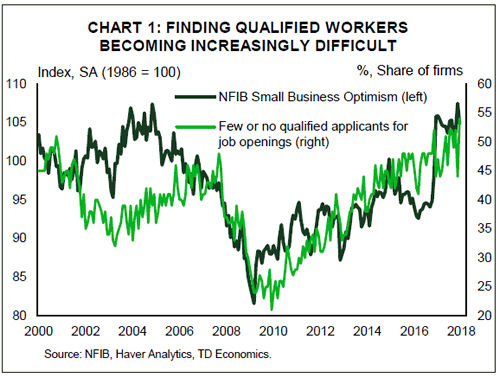
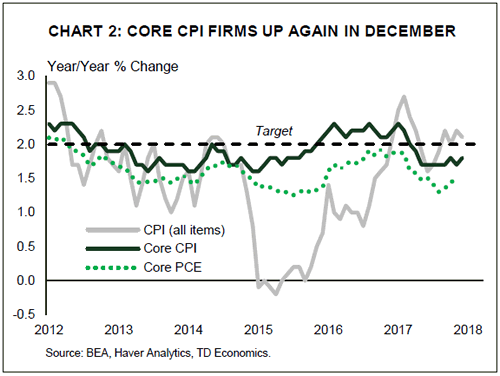
Canada – Slowly But Surely, Higher Interest Rates On The Way
It was a quiet week on the Canadian data front, but oil was shining bright, with the WTI benchmark reaching a 3-year high of nearly US$64 per barrel and the Canadian WCS benchmark reaching US$38 per barrel after hitting a low of US$29 per barrel in December.
While inventories have come down somewhat, global supply is still abundant, suggesting that global prices have run too high too fast. Speculative activity has played a role in the run-up in prices in recent weeks, with WTI net long positions on the NYMEX sitting at a record high. Improving prospects for global growth, uncertainty and tensions in the Middle East and a decline in U.S. inventories have contributed to the optimism in the market. However, prices over US$60 per barrel will lead to more U.S. shale production, prolonging the rebalancing period. The U.S. Energy Information Administration (EIA) revised up its 2018 forecast for U.S. production by nearly 200k barrels per day this week, with output now expected to hit a record in the first quarter, three quarters earlier than previously thought. With production on the rise in the U.S. – in addition to increases in Canada, Brazil and the North Sea – it is unlikely that prices will stay above that threshold on a sustained basis. What’s more, with such a high level of speculation in the market, the risks for prices are heavily skewed to the downside.
The Canadian dollar did not benefit from higher oil prices, as it fell back below the 80 US cent level this week. Much of the weakness came following news that Canadian government officials said that there is an increasing likelihood that President Trump will pull out of NAFTA. The next set of negotiations are scheduled to take place in Montreal on January 23-28, with another round scheduled to happen in Mexico in February. A U.S. withdrawal from NAFTA would have significant ramifications for the Canadian economy, but the recent concerns are unlikely to prevent the Bank of Canada from hiking the overnight rate next Wednesday, particularly given recent suggestions that negotiations could in fact be prolonged further, stretching into the Summer to account for upcoming Mexican elections.
Governor Poloz has indicated that interest rate decisions will be data dependent and most recent data releases point to higher interest rates. In addition to the stellar jobs report released last Friday, this week’s housing starts data showed that builders broke ground on a solid 217k new homes in December. Moreover, the Bank of Canada’s Business Outlook Survey – a key forward-looking indicator – revealed that sentiment among Canadian businesses remained positive during the final quarter of 2017. Healthy hiring and investment intentions indicate underlying strength in the economy and less need for emergency level interest rates.
That said, a rate hike next week does not necessarily mean that the Bank will embark on a rapid tightening cycle. Given high household debt levels, uncertainty surrounding the impact of the B20 mortgage measures and risk associated with the NAFTA renegotiations, the Bank must be careful in how quickly it raises rates so as to not derail the economy. As such, we expect a gradual pace of tightening over the next two years, of about 25 bps every six months.

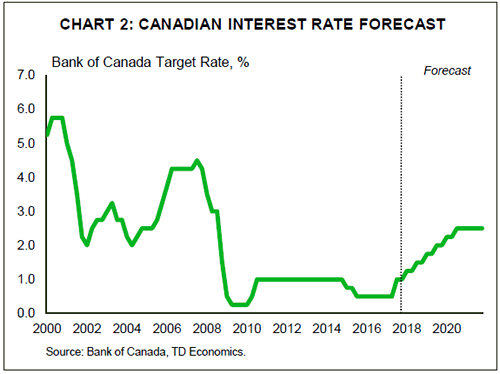
Canada: Upcoming Key Economic Releases
Bank of Canada Rate Decision
Date: January 17, 2018
Previous Result: 1.00%
TD Forecast: 1.25%
Consensus: 1.25%
NAFTA rumours have injected a dose of uncertainty into next week’s meeting but we do not think they will be enough to derail a rate hike that’s 80% priced by the market and almost universally expected by economists. We look for Poloz’s data dependence to outweigh his risk management framework. The evolution of data since the December FAD has been undeniably upbeat, as evidenced by further gains in CPI and the labour market, while the one GDP report that disappointed was weighed down by transitory factor. With a January rate hike well priced, the larger question for markets will be whether Poloz tries to talk down an OIS curve which is pricing in over three hikes for 2018. Given Poloz’s aversion to forward guidance, we think it is unlikely he tries to steer market expectations with a "dovish hike" but watch out for a speech in the near future to reprice markets.
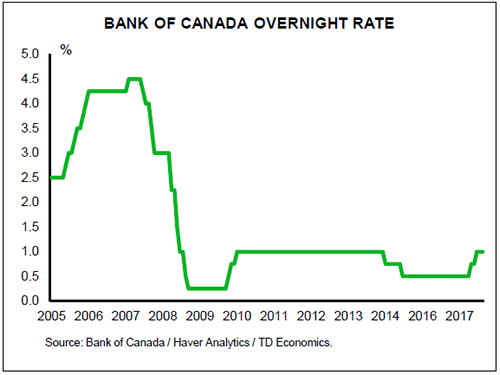
Canadian Manufacturing Sales – November
Release Date: January 19, 2018
Previous Result: -0.4% m/m
TD Forecast: 2.1% m/m
Consensus: 1.5% m/m
We expect manufacturing sales to post a firm 2.1% m/m rebound in November led by a partial normalization of motor vehicle production. Imports of motor vehicle parts surged in November, pointing to a rebound in assemblies after retooling shutdowns constrained output in the prior month. Energy products will be another source of nominal upside owing to a surge in gasoline prices, while volumes could see marginal benefit from pipeline shutdowns that restricted the flow of crude oil to US refineries. Outside of these two industries, the combination of a broad increase in factory prices and a pickup in hours worked favours a strong rebound from October. We expect real manufacturing sales to underperform the nominal print with a gain of roughly 1%, but nonetheless contribute positively to industry-level growth.
Chart: Canadian Manufacturing Shipments
